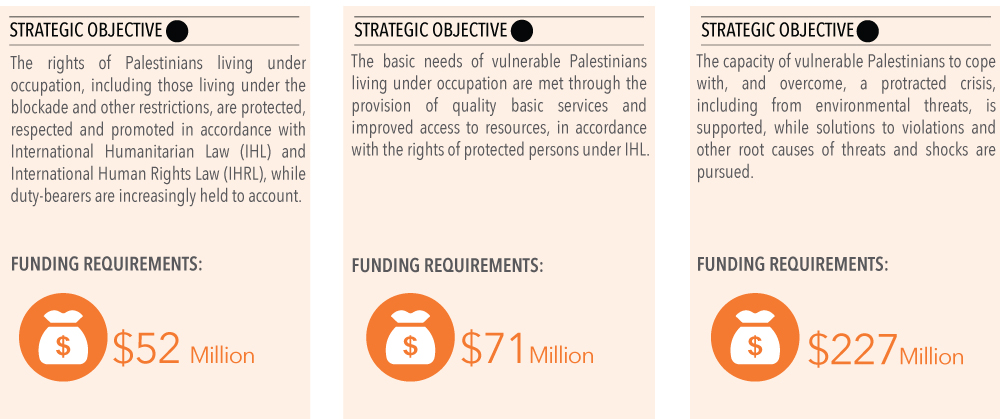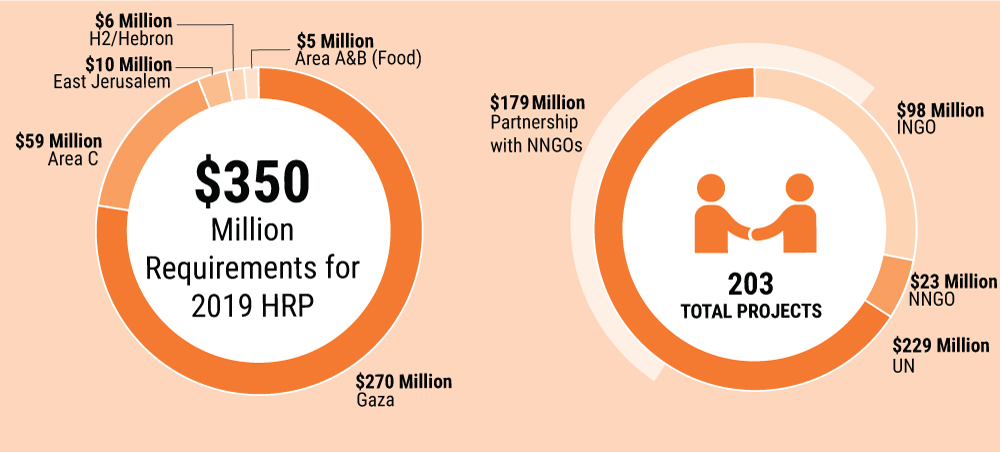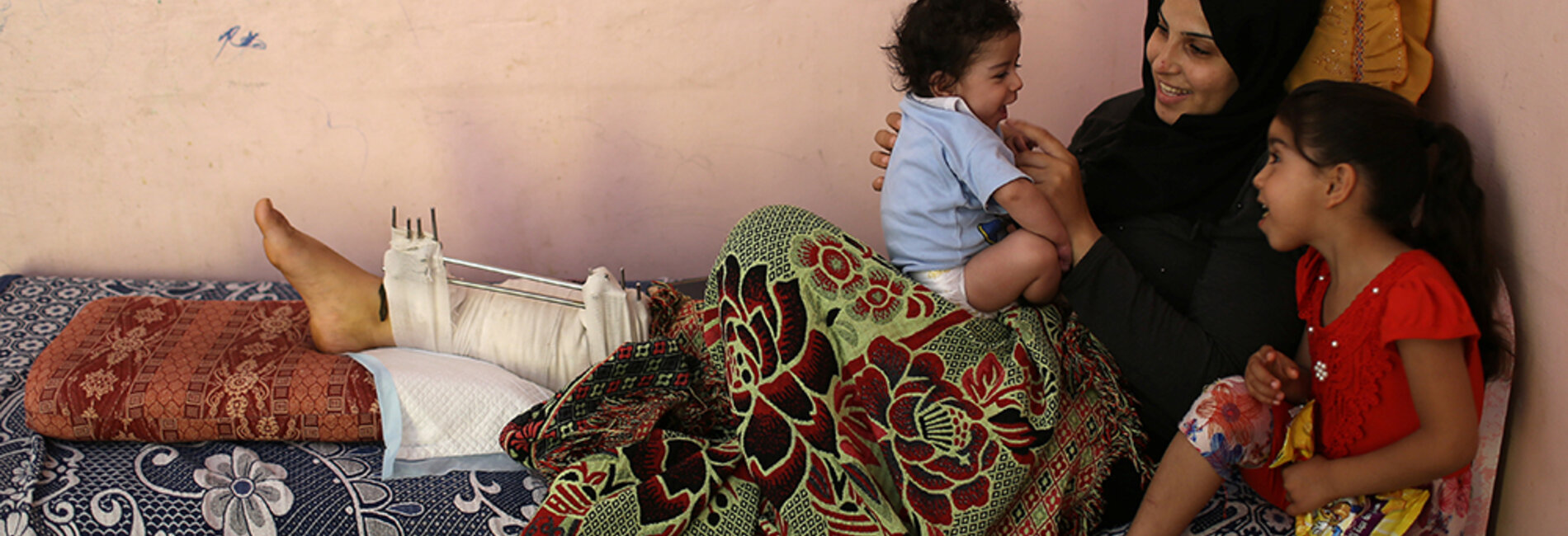$350 million requested to respond to humanitarian needs for 1.4 million Palestinians in 2019
About 2.5 million Palestinians across the occupied Palestinian territory (OPT), or approximately half of the population, are identified as in need of humanitarian assistance and protection according to the 2019 Humanitarian Needs Overview (HNO). Of these, 1.4 million, identified as the most vulnerable, are to be targeted in 2019 by a range of interventions outlined in the Humanitarian Response Plan (HRP) at a total cost of US$350 million. The 2019 HRP was launched jointly by Jamie McGoldrick, the Humanitarian Coordinator, with the Minister of Social Development of the State of Palestine, Dr. Ibrahim Al Shaer, in Ramallah on 17 December.
Rising needs amid a constrained operational environment
In the 2018 HRP, 1.9 million Palestinians were targeted for assistance at a total cost of $539.7 million. The reduction in the number of beneficiaries to be targeted and funding requested for 2019 does not reflect a lower level of humanitarian need. On the contrary, there has been a sharp deterioration in the humanitarian situation in 2018, particularly in the Gaza Strip: poverty, unemployment and food insecurity have increased and there has been an enormous rise in Palestinian casualties as a result of the “Great March of Return” (GMR) demonstrations. Economic growth is declining in the West Bank, where settlement expansion, settler violence, demolitions and evictions are intensifying the coercive environment on vulnerable Palestinian communities.
As the situation worsens, humanitarian and civil society organizations are facing an increasingly constrained operational environment. Access restrictions, political considerations by donors and a rise in attacks designed to delegitimize humanitarian action are placing greater challenges on the ability of humanitarian actors to provide protection and assistance (See next article in this Bulletin).

Funding for the OPT at an all-time low
Concurrent with increased needs and operational constraints, funding for humanitarian activities is declining; only 44.4 per cent of the $539.7 million requested for the 2018 HRP was secured, significantly lower than the global average of nearly 58 per cent. The shortfall is mainly attributable to the decline in contributions to UNRWA by the United States, the Agency’s largest contributor, but reflects a trend of reduced funding for humanitarian agencies across the OPT. This situation is not expected to improve in 2019 as donors indicate that current funding levels will be maintained at best.
As no improvements are currently foreseeable in the humanitarian situation, in the resources required to meet rising needs or in the operating space for humanitarian activities, the 2019 HRP has been revised to identify what can be done with the existing political and resource climate. The target of 1.4 million beneficiaries is based on the maximum number of vulnerable people who can realistically be provided with basic food, healthcare, shelter, and water and sanitation in 2019, if the required funding is received. The $350 million requested to meet these needs is $190 million lower than the 2018 HRP and is designed to maximize the benefits of limited funding in a restrictive environment.
The funds actually needed to provide humanitarian assistance to all 2.5 million Palestinians in need is an estimated $800 million. Should more funding become available, humanitarian partners are ready to scale up their response to reach more people.
Launching the 2019 HRP, the Humanitarian Coordinator stated: “It is the most prioritized and focused it could possibly be. We have done this in consultation with donors so we expect a better donor response to this plan. In requesting $350 million we are asking for more than we actually received in 2018, but this is well below the real needs. We recognize that much more assistance is needed. We stand ready to do much more but to do so, we must be able to access communities without interference. We must be able to get our staff in and out, and between, all parts of the occupied Palestinian territory. We must be able to deliver goods and services to the people who need them. Palestinian and Israeli authorities need to facilitate our work rather than undermine it.”

What is the Humanitarian Response Plan?
The HRP represents a collective plan by the international community to respond to the most urgent humanitarian needs identified by partners across the OPT. The 2019 HRP forms part of a multi-year plan for the period 2018-2020 and is guided by the same strategic objectives as last year:
- To protect the rights of Palestinians living under occupation in accordance with international law, while duty-bearers are increasingly held to account;
- To ensure that the basic needs of vulnerable Palestinians are met through the provision of quality basic services and improved access to resources;
- To ensure that the capacity of vulnerable Palestinians to cope with the situation is supported, while solutions to violations and other root causes of threats and shocks are pursued.
The situation in the OPT continues to be characterized as a protracted protection crisis, largely attributable to Israel’s ongoing occupation of the West Bank, including East Jerusalem, and Gaza Strip, the continuing internal Palestinian divide and violations of international law. Accordingly, the centrality of protection has been maintained as a shared system-wide responsibility throughout the 2019 HRP, with approximately 10 per cent ($36 million) of the total funding requested targeting ongoing protection needs.
Food, shelter, water, sanitation and hygiene (WASH) projects have undergone stricter prioritization this year in response to the restrictive funding environment. As in previous years, the majority (approximately 59 per cent or $206 million) of the funding requested is to provide food assistance to the 1.7 million Palestinians who are moderately to severely food insecure. Exceptionally, requirements for the health sector has increased (nine per cent, $30 million) as conditions in Gaza have deteriorated due to the surge in casualties from the GMR demonstrations. The remaining 32 per cent requested ($104 million) will address a range of projects in WASH, coordination, education and shelter.
The 2019 HRP encompasses 203 projects to be implemented by 88 organizations, including 38 national and 37 international NGOs, and 13 UN agencies. About 77 per cent of the funds requested target Gaza, while the other 23 per cent focus on Area C, the Israeli-controlled area of Hebron city (H2) and East Jerusalem in the West Bank.
As in previous years, the humanitarian community’s ability to implement the 2019 HRP, and associated projects and activities, is fully reliant on receiving the requested $350 million via voluntary donor contributions.










